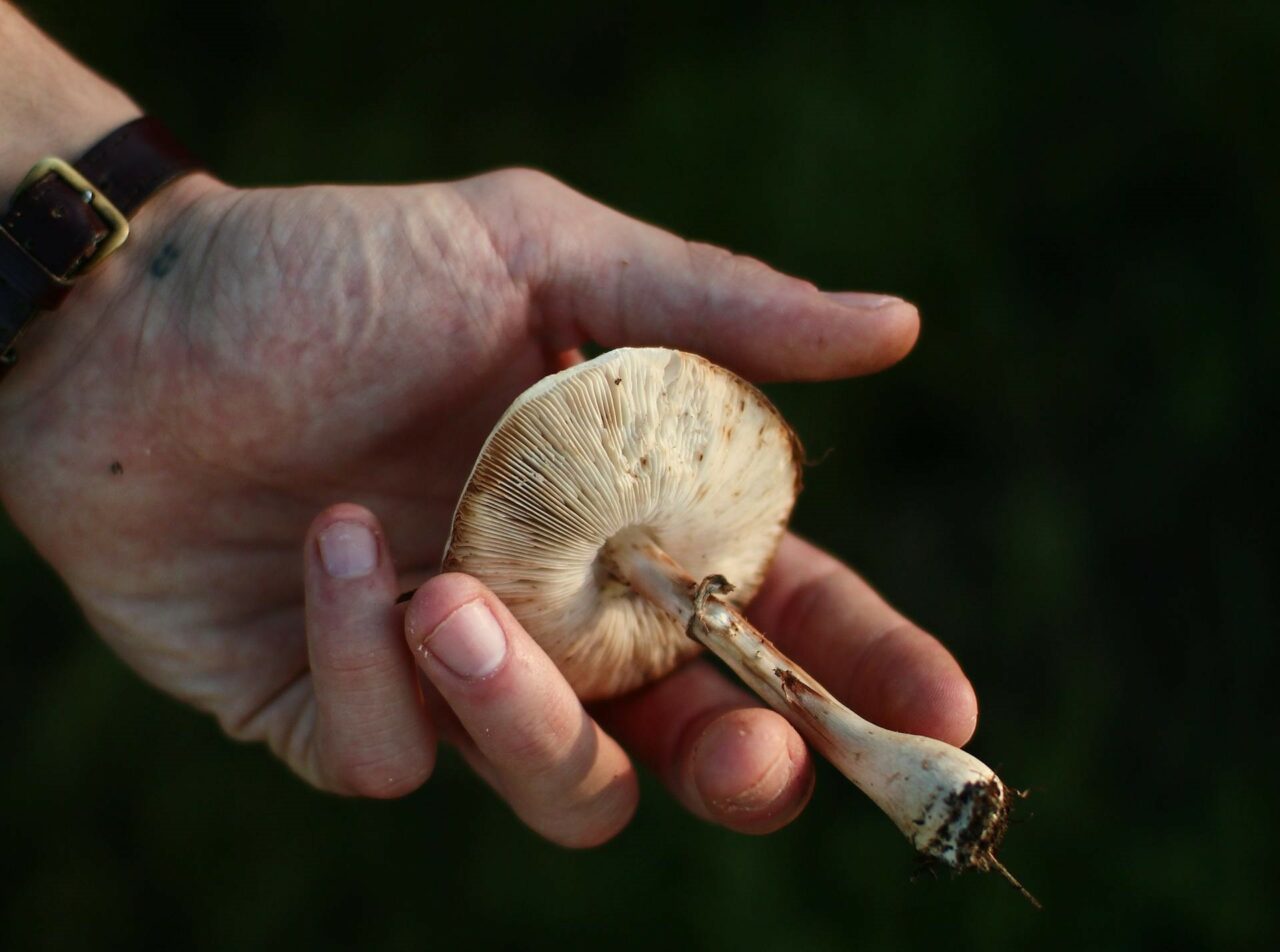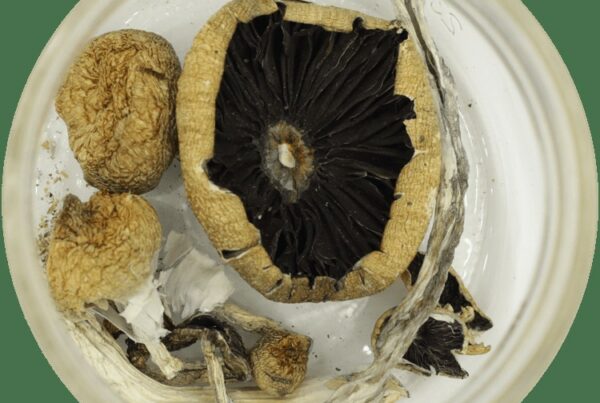Psilocybin mushrooms, akin to LSD in their function as a serotonin 5-HT2A receptor agonist, are a classic form of psychedelic. Current research is exploring their potential for psilocybin-assisted therapy in treating mental health disorders such as major depression, anxiety, cluster headaches, and migraines.
In order to understand how shrooms can assist with these conditions, it’s imperative to examine their metabolic process in the human body. This knowledge enables both researchers and users to comprehend how the active compound triggers psychological and therapeutic effects. This article offers a basic overview of psilocybin’s pharmacology and pharmacokinetics.
[toc]
Key Points:
- Half of the psychedelic fungi consumed orally is absorbed and distributed throughout the body.
- The fungi compound is dephosphorylated by the enzyme alkaline phosphatase, primarily in the liver.
- Approximately 3.4% of the compound is expelled in its original form within 24 hours, while the bulk is excreted as a stable metabolite.
What Does Pharmacokinetics Mean?
Pharmacokinetics (PK) refers to the study of how substances, such as drugs, are processed by the body once ingested. It is distinct, yet related to pharmacodynamics, which focuses on how a compound interacts with the body. PK investigates four main facets: absorption, distribution, metabolism, and excretion (ADME).
Comprehending these processes enables healthcare providers to prescribe the most advantageous medications with the least risk. It also allows them to customize treatments to the unique physiological and lifestyle attributes of each patient.
How Does Pharmacokinetics Relate to Psilocybin?
Psilocybin and psilocin, the primary active compounds in some species of magic mushrooms, have garnered considerable attention from researchers and users. Pharmacokinetics studies how the body interacts with mushrooms that contain psilocybin and aims to clarify their potential effects, be they medicinal or recreational.
These compounds are referred to by various names, such as “magic,” “psychedelic,” “medicinal,” or “sacred.” The fungi containing these compounds are consumed, with The types of mushrooms, their place of origin, size, the conditions they thrive and dry under, and their age can all contribute to significant variations in their concentrations.
Although these mushrooms naturally exist in the wild, scientists have found ways to artificially create them in labs. Both the natural and lab-grown versions exhibit low toxicity, though they may lead to minor side effects like nausea or vomiting.
Despite these physical effects, the compounds in these mushrooms have revealed potential therapeutic benefits due to their safety and non-addictive properties. These benefits have sparked interest among researchers to explore their application in psychotherapy, particularly for treating anxiety and depression.
Four Stages of Pharmacokinetics
Psilocybin, the compound present in these mushrooms, is initially inactive and acts as a prodrug, converting into its active form, psilocin. Enzymes such as alkaline phosphatase facilitate this transformation, enabling psilocin to be absorbed and distributed throughout the body to reach various tissues. However, after oral intake, psilocybin cannot be detected in the circulatory system, feces, or urine.
Absorption
Absorption refers to the process by which the compound enters the bloodstream from the point of administration. It dictates the pace and effectiveness with which the compound reaches its target, such as the plasma. Oral consumption is the most common method of administration. Inhalation has been tried, but it is not as efficient as ingestion.
The absorption process also encompasses the release of the compound from the dosage form during oral ingestion. Factors that might delay the journey through the throat or esophagus can affect this process, potentially causing a slowdown in results or irritation. Once the compound arrives in the stomach, the acidic environment may start to degrade it before it enters the bloodstream.
Studies on animals suggest that only around 50% of orally ingested psychedelics are absorbed and distributed throughout the body.
Factors Affecting the Absorption Process
Several elements can influence the absorption process, leading to variations in the onset, intensity, and duration of the effects:
- Stomach Contents: Consuming mushrooms on a full stomach can slow down the process as it delays the onset of effects. Absorption is quicker on an empty stomach.
- Body Fat: Compounds may accumulate in fat tissues, potentially prolonging their effects.
- Age: With advancing age, changes occur in metabolic rates and body composition.
- Zero-Order Kinetics: The substance is discarded at a uniform rate, regardless of its concentration.
- First-Order Kinetics: The elimination rate is directly proportional to the concentration of the drug.
The distribution process is influenced by various factors such as the size, polarity, and protein-binding capacity of the substance, as well as characteristics of the individual’s body, including hydration status and body composition.
The goal is to reach a sufficient concentration at the intended target site. For effectiveness, the substance must arrive at the designated location (as defined by the volume of distribution) and remain unbound to proteins, thus allowing it to actively engage with its receptor.
What Factors Affect the Distribution Processes?
Several elements can influence the distribution process:
Typically, the effects begin to manifest within 20-40 minutes of consumption, reaching a peak at around 80-100 minutes. The effects of magic mushrooms generally last between 4-6 hours.
How Does Psilocin Reach the Brain?
Early experimental research on two species demonstrated the binding affinity sequence as 5HT2A > 5HT1A > 5HT2B [23]. Psilocin also binds to dopamine D1, 5HT1E, 5HT5A, 5HT7, 5HT6, D3, 5HT2C, and 5HT1B receptors.
Psilocin acts as a partial agonist at the 5HT2A receptor, with an efficacy of about 40%. Its psychedelic effects are thought to stem from its partial agonistic activity at 5HT1A autoreceptors.
The enhancement of mood and psychotomimetic experiences may be connected to the observed link between increased dopamine levels and feelings of depersonalization and euphoria. Hallucinogens work by modifying neurochemistry and receptor activity. They augment 5HT2A agonist activity by boosting BDNF synthesis in the hippocampus, which promotes neurogenesis and reduces fear-related behaviors.
Elimination Process
Excretion refers to the process by which the
The human body expels substances through multiple avenues, including the kidneys, lungs, skin, and gastrointestinal tract. Specifically, natural psychedelic drugs are either filtered by the kidneys’ glomerulus or secreted in the tubules, with some reabsorption adding layers of complexity to the elimination process.
The primary substance has a half-life of roughly 160 minutes, whereas psilocin has a half-life close to 50 minutes. Animal studies suggest that the majority of the substance is expelled through urine, accounting for about 65% within 8 hours post-consumption. Trace amounts can also be detected in the bile and feces.
In the human body, it is estimated that around 3.4% of the substance is eliminated in its original form within 24 hours. However, most of it is expelled as psilocin-O-glucuronide, a more stable metabolite. This stability allows the substance to be detectable in urine samples for an extended duration.
The two primary methods of substance elimination are:
Most psychedelic drugs are eliminated following the first-order kinetics method, reaching steady-state concentrations after four to five half-lives. Complete removal also occurs after approximately four to five half-lives.
Discover Our Range of Hallucinogenic Mushrooms
The metabolic processes can differ amongst various types of fungi. By choosing to buy from reliable online providers like Deadhead Chemist Canada, you can avoid the risk of ingesting harmful mushrooms. Certain types, like Agaric mushrooms, can induce intense and undesirable effects. Hence, it’s crucial to procure magic mushrooms from trustworthy sources, rather than unreliable street vendors or wild picking.
| Feature | Enigma | Full Moon Party | Gold Member | |
| Strain Type | Psilocybe Cubensis OMNI | Psilocybe cubensis (Thai Koh Samui) | Psilocybe cubensis | |
| Potency | Exceptionally high; 3.8% tryptamine content | Moderate to high potency | High potency | |
| Visual Characteristics | Resembles a blob or | Resembles a cauliflower or a brain | Exhibits a typical cubensis look; moderately sized | Robust white stems; caps with a golden caramel hue; visible blue bruising |
| Effects | Recognized as highly potent; triggers intense effects | Potent mental uplift; onset is delayed but visuals are striking | Strong visual effects and euphoria |
Online Education on Psilocybin Mushroom Usage
Comprehending the pharmacokinetics of shrooms is crucial for healthcare providers, researchers, and users. Armed with this knowledge, you can make well-informed decisions regarding dosage and timing, thus minimizing potential hazards.
Discover your perfect psychedelic experience at Deadhead Chemist Canada. Whether you’re after a soothing journey or a deep exploration, our extensive product collection is tailored to meet your specific requirements. Enjoy top-notch, safe, and quality-assured shrooms, eliminating worries about unidentified sources or poisonous mushrooms.
Indulge in the best magic mushrooms Canada provides and elevate your psychedelic exploration to new heights.
Frequently Asked Questions
Are there any recognized interactions between shrooms and other drugs?
Our products may interact with certain medications, particularly those that affect serotonin levels, like SSRIs (Selective Serotonin Reuptake Inhibitors). SSRIs and SNRIs (Serotonin and Norepinephrine Reuptake Inhibitors) tend to reduce the effects, unlike non-serotonergic antidepressants. This reduced effect can last for up to three months after stopping the usage of the antidepressant.
Do all psychedelics share the same pathway as psilocybin?
No, each psychedelic compound has a unique structure that requires different metabolic processes to activate, and they bind to various receptors in the body. The route of administration also affects the absorption of each psychedelic. While the basic principles of absorption, metabolism, and distribution stay the same, the specific pathways and effects vary for each substance.
Can the form of the mushroom affect pharmacokinetics?
Indeed, the form (be it fresh, powdered, or dried mushrooms) can influence the absorption rate. For example, powdered forms may be absorbed faster than whole dried ones due to quicker dissolution.
Suggested Reads:





